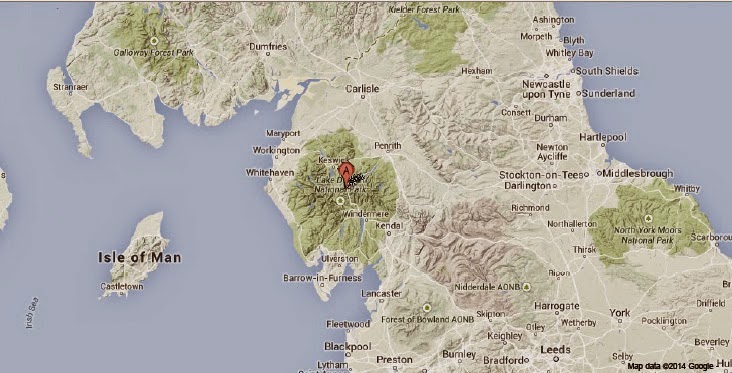The British Geological Survey recorded a Magnitude 2.0 Earthquake at a depth of 12 km about 20 km to the southeast of the town of Kendle in Cumbria, northwest England, slightly before midday GMT on Monday 9 February 2015. Earthquakes of this size present no danger to human life or property, but may be felt locally.
The approximate location of the 9 February 2015 Cumbria Earthquake. Google Maps.
Earthquakes become more common as you travel north and west in Great
Britain, with the west coast of Scotland being the most quake-prone part
of the island and the northwest of Wales being more prone to quakes
than the rest of Wales or most of England. However, while quakes in
southern England are less frequent, they are often larger than events in
the north, as tectonic presures tend to build up for longer periods of
time between events, so that when they occur more pressure is released.
The precise cause of Earthquakes in the UK can be hard to determine; the
country is not close to any obvious single cause of such activity such
as a plate margin, but is subject to tectonic pressures from several
different sources, with most quakes probably being the result of the
interplay between these forces.
Britain is being pushed to the east by the expansion of the Atlantic Ocean and to the north by the impact of Africa into Europe from the south. It is also affected by lesser areas of tectonic spreading beneath the North Sea, Rhine Valley and Bay of Biscay. Finally the country is subject to glacial rebound; until about 10 000 years ago much of the north of the country was covered by a thick layer of glacial ice (this is believed to have been thickest on the west coast of Scotland), pushing the rocks of the British lithosphere down into the underlying mantle. This ice is now gone, and the rocks are springing (slowly) back into their original position, causing the occasional Earthquake in the process.
(Top) Simplified diagram showing principle of glacial rebound. Wikipedia.
(Bottom) Map showing the rate of glacial rebound in various parts of
the UK. Note that some parts of England and Wales show negative values,
these areas are being pushed down slightly by uplift in Scotland, as the
entire landmass is quite rigid and acts a bit like a see-saw. Climate North East.
Witness accounts of Earthquakes can help geologists to understand these
events, and the structures that cause them. If you felt this quake, or
were in the area but did not (which is also useful information) then you
can report it to the British Geological Survey here.
See also...
 Magnitude 2.0 Earthquake in the Lake District, England. The British Geological Survey recorded a Magnitude 2.0 Earthquake at a depth of 13 km at the southern
end...
Magnitude 2.0 Earthquake in the Lake District, England. The British Geological Survey recorded a Magnitude 2.0 Earthquake at a depth of 13 km at the southern
end...
The British
Geological Survey recorded a Magnitude 1.8 Earthquake at a depth of 4 km
approximately 5 km north of the village of Grasmere, in the Lake
District in Cumbria...
On
Friday 21 March 2013, slightly before 4.15 am, the British Geological
Survey recorded a Magnitude 1.2 Earthquake at a depth of 3 km between
Lake Ulswater and Haweswater Reservoir. This is a small quake...
Follow Sciency Thoughts on Facebook.





